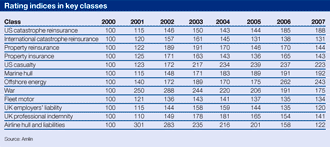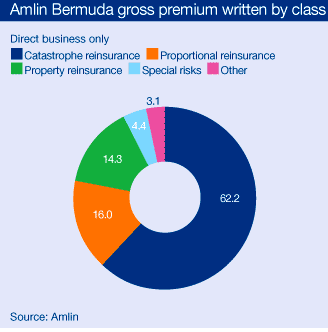Review
Underwriting – managing profitability through a changing environment
Reacting to market conditions
Amlin’s diversity, combined with the strength of its underwriting teams continues to allow us to flex the business mix, taking account of market conditions and our risk appetite. We seek to optimise the riskreturn relationship through the cycle and have historically allowed premium income levels to fluctuate in response to market conditions and prospects for each class of business.
A key aim of Amlin’s underwriters is to produce a gross underwriting profit. Reinsurance is purchased to alleviate the impact of severe and infrequent loss experience, not to support inadequate original pricing. To achieve a gross profit, underwriters need to be able to calculate and achieve a technical price for coverage being given. In the current trading climate this stance results in reducing levels of income for many classes. There are a number of longstanding clients who wish to maintain Amlin as a leader or participant and recognise that they may have to pay more than others at this stage of the cycle. These clients remain the core part of our portfolio. In some instances, long term relationships are maintained by our underwriters continuing to participate with a reduced line.
The benefit of selectivity should also be reflected in the cost of reinsurance as reinsurers are willing to provide coverage at lower rates, underpinned by the knowledge that the underwriters are exercising underwriting discipline.
A good example of cycle management in action in recent years has been our airline portfolio, with the reduction in exposure to major airlines since the market peak in 2002. In 2002, the Aviation division underwrote 43 major airlines, leading on ten of these. By 2007, the division wrote ten major airlines and led on five. The reduction in the portfolio of risks has increased the potential for the division to avoid losses and still make a gross underwriting profit. During 2007 there were 20 large insurance loss events to the airline industry, each costing over US$10 million, which totalled an estimated US$1.1 billion in insured loss. Amlin were involved in two of these losses at a total cost of US$2.0 million. With a market share of approximately 4% of premium, a 0.1% share of losses is an impressive result.
Managing through 2007
Gross premium written reduced by 6.2% overall to £1,044.7 million, with 77% of 2006 business being renewed with an average 5% rate reduction across our business. Rating levels across a number of major classes of business are shown in the table below.
Rating indices in key classes

Click here for full sized image
Premium changes by business area for 2007 underwriting year (net of brokerage)

Click here for full sized image
Premium changes by business area for the 2007 underwriting year, alongside the renewal rates experienced, are provided above. The impact of our disciplined underwriting approach, whereby 2007 income reduced for the majority of classes in line with increased pricing pressure, is evident. The exceptions to this are small value businesses such as yacht, bloodstock and binders where the rating pressure is less evident and growth in the excess of loss reinsurance accounts due to the marketing efforts of Amlin Bermuda.
It is apparent from the chart below, showing line size maximums and average utilisation, that underwriters also exercised selectivity by reducing lines on some less attractive risks to achieve a better balance of exposure and income.
In managing their portfolios, our underwriters attempt to improve performance by selectively adding new business and reducing exposure to poorer quality business. Underwriting statistics for new and renewal business are analysed on a quarterly basis and have shown that for most classes the loss ratio for new business bears favourable comparison with the renewal book. The technical price for both new and renewal business is also captured to ascertain if rating levels differ markedly.
Progress of Amlin Bermuda
In 2007 Amlin Bermuda produced £232.8 million of gross premium, an increase of 4.2% on the prior year and a significant contribution to the overall Group result. In 2007, 1264 contracts were written for over 400 reinsurance clients. Catastrophe reinsurance continues to account for a large part of Amlin Bermuda’s portfolio, generating 62% of direct premium income in 2007 (2006: 60%). The company continues to write a whole account quota share treaty of Syndicate 2001 which has been increased from a 10% to a 12.5% cession for 2008. Specific proportional facilities also exist which enable the Syndicate to write larger lines on individual risks in marine and property classes as required.

The recent action of rating agency AM Best to upgrade Amlin Bermuda to a financial strength rating of A, the expansion of the underwriting team from 2 to 4 people, and a modest increase in risk appetite, will assist in the marketing efforts being carried out by the team, and continued controlled expansion of the portfolio is expected in 2008.
